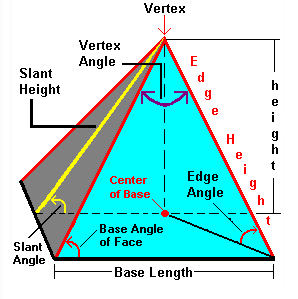Polygon Calculator
The figure above is a regular polygon - its base is a regular polygon, its sides are all congruent isosceles triangles, and its verticesare perpendicular to the base.

A Polygon Calculator is a tool used to calculate various properties of polygons, which are two-dimensional shapes with straight sides. Depending on the type of polygon and the available inputs, the calculator can help determine properties such as the perimeter, area, interior angles, and more. It is especially useful for both regular polygons (where all sides and angles are equal) and irregular polygons (where sides and angles may differ).
1. What is a Polygon?
A polygon is a closed, two-dimensional shape with straight sides. The key characteristics of a polygon are:
- Number of sides: Polygons are named based on the number of sides they have (e.g., triangle for 3 sides, square for 4 sides, pentagon for 5 sides, etc.).
- Vertices: The points where two sides of a polygon meet.
- Angles: The interior angles formed at each vertex.
A polygon can be regular (where all sides and angles are equal) or irregular (where sides and/or angles are different).
2. Why Use a Polygon Calculator?
A Polygon Calculator is useful for several reasons:
- Efficiency: It quickly provides the answers to common polygon-related calculations, saving time and reducing the chance of errors.
- Geometric Analysis: It helps analyze and work with polygons in geometry, architecture, and engineering.
- Design and Construction: It assists in the design of objects with polygonal shapes (such as tiling, flooring, or structures with polygonal features).
- Mathematical Problem Solving: For students, researchers, or professionals who need to solve problems involving polygons in fields like mathematics, physics, or computer graphics.
3. How Does a Polygon Calculator Work?
The Polygon Calculator works by applying formulas that depend on the type of polygon and the available information (e.g., number of sides, side length, apothem, or angle measures). Depending on the type of calculation you're performing, you may need to input different values:
For Regular Polygons (all sides and angles are equal):
-
Perimeter (P): The perimeter is calculated by multiplying the side length by the number of sides:

Where:
- n is the number of sides.
- s is the side length.
-
Area (A): The area of a regular polygon is given by:

Where:
- n is the number of sides.
- s is the side length.
- π is approximately 3.14159.
-
Interior Angles (I): The interior angle of a regular polygon can be calculated using:

Where:
- nn n is the number of sides.
For Irregular Polygons:
-
Perimeter: For an irregular polygon, the perimeter is simply the sum of the lengths of its sides:

Where:
- s1,s2,s3,…,sn are the lengths of the individual sides.
-
Area: For irregular polygons, calculating the area can be more complex and may involve dividing the shape into smaller, simpler shapes (e.g., triangles) or using methods like the shoelace theorem for polygons with known vertices.
4. When to Use a Polygon Calculator?
You would use a Polygon Calculator in the following situations:
- Mathematics: When solving problems in geometry or trigonometry that involve polygons, such as finding the area, perimeter, or interior angles of different shapes.
- Design and Architecture: When designing floor plans, tiles, roofs, or other structures that involve polygonal shapes and require calculations for area or perimeter.
- Construction: For determining how much material is needed to cover a polygonal surface, such as fencing, paving, or roofing with polygonal sections.
- Engineering and Manufacturing: For calculations related to creating polygonal components or structures, such as in mechanical parts, gears, or polyhedral structures.
- Computer Graphics: In computational geometry, graphics programming, or modeling where polygons are frequently used to represent shapes in 2D and 3D environments.